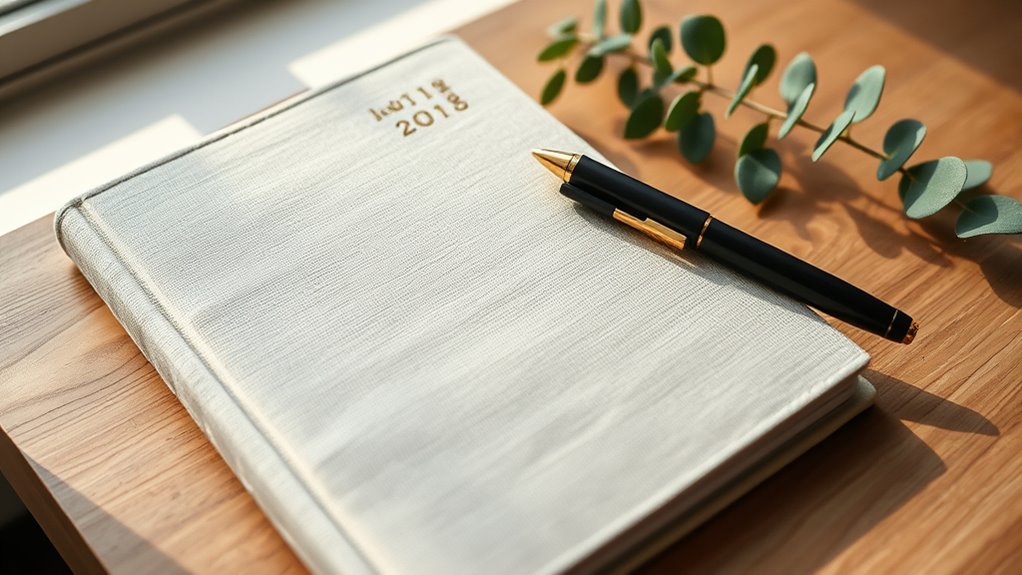To select an effective mindfulness journal, choose one that feels inviting and fits your style, whether physical or digital. Look for features like prompts, space for reflection, and gratitude sections to guide your practice. To use it well, establish a routine by setting aside specific times, keep it accessible, and focus on non-judgmental awareness. Incorporating different reflection techniques can deepen your experience—keep exploring to discover how to make it work best for you.
Key Takeaways
- Choose a journal with prompts that align with your mindfulness goals, such as gratitude or self-reflection.
- Opt for a format you enjoy, like lined, unlined, or digital, to encourage consistent use.
- Set a specific time daily to journal, creating a routine that reinforces mindfulness practice.
- Use prompts to guide your reflection, focusing on present-moment awareness and non-judgmental observation.
- Create a calming, dedicated space for journaling to foster a safe environment for honest exploration.

Mindfulness journals have become a popular tool for cultivating awareness and reducing stress in daily life. When you start using one, you’ll discover that the key to making it effective lies in consistent practice and intentional reflection. Incorporating daily prompts into your journaling routine can help you stay engaged and focused. These prompts serve as gentle nudges to explore your thoughts, feelings, and experiences, guiding you toward greater mindfulness. Whether you’re new to journaling or have been at it for a while, using daily prompts can make your practice more structured and meaningful. They can range from simple questions like “What am I grateful for today?” to more introspective ones such as “What emotions did I notice today, and what triggered them?” This variety encourages you to explore different aspects of your inner world and develop a deeper awareness of your habitual thought patterns.
Reflection techniques are equally essential in a mindfulness journal. They help you process your experiences without judgment and foster a compassionate attitude toward yourself. Techniques like noting sensations, describing your feelings in detail, or even writing about what you’re grateful for are straightforward yet powerful ways to deepen your practice. When you write, try to focus on the present moment, observing your thoughts and feelings without trying to change or fix them. This mindful approach creates space for acceptance and understanding. Over time, these reflection techniques can help you recognize recurring themes or triggers, making it easier to respond with calmness and clarity rather than reacting impulsively. Practicing mindfulness through journaling can also support your spiritual growth and emotional resilience.
To get the most out of your mindfulness journal, set aside a specific time each day for writing, whether it’s morning, midday, or evening. Consistency helps establish a routine and signals to your brain that mindfulness is a priority. Keep your journal accessible; some people prefer a dedicated notebook, while others use digital apps. The most important thing is to create a safe, inviting space where you feel comfortable exploring your inner landscape. Remember, your journal isn’t about producing perfect entries but about cultivating awareness and compassion. By integrating daily prompts and reflection techniques into your practice, you’ll build a more resilient, mindful mindset that can serve you well through life’s ups and downs. Engaging in meditation alongside journaling can further enhance your sense of peace and clarity.
Frequently Asked Questions
Can Mindfulness Journals Replace Therapy or Counseling?
Mindfulness journals can’t replace therapy or counseling, but they can serve as valuable therapy alternatives for emotional support. You might find journaling helps you process feelings, track progress, and gain insight into your mental health. However, if you’re facing serious issues, it’s crucial to seek professional help. Use a mindfulness journal as a supplement to therapy, not a substitute, to enhance your emotional well-being and self-awareness.
Are Digital Mindfulness Journals as Effective as Paper Ones?
Did you know 65% of users find digital mindfulness journals just as effective as paper ones? Digital journals offer convenience and instant access, but some people worry about accessibility concerns like screen fatigue or tech issues. If you prefer flexibility and easy tracking, digital can work well. However, if you value a tactile experience or worry about tech barriers, paper journals might suit you better. Choose what fits your lifestyle for maximum benefit.
How Often Should I Update or Change My Journal?
You should update your journal regularly, ideally daily or at least a few times a week, to keep your updating routines effective. This frequency helps you stay mindful and track progress without feeling overwhelmed. Adjust your journal frequency based on your needs and schedule, but consistency is key. Change or refresh your journaling approach when it feels stagnant, ensuring your routines stay engaging and meaningful.
What Are Common Mistakes to Avoid When Starting a Journal?
You might start journaling and find yourself editing later, thinking it’s too messy. Avoid this by maintaining journal consistency and being emotionally honest. For example, if you hide your true feelings, your progress stalls. Don’t judge your entries; embrace imperfection. Focus on genuine reflection, not perfection. This approach helps you stay committed and release the full benefits of mindfulness journaling.
Can Mindfulness Journaling Help With Specific Mental Health Issues?
Yes, mindfulness journaling can help you with specific mental health issues. It promotes emotional regulation by helping you identify and process feelings more clearly. Additionally, it reduces stress by encouraging reflection and present-moment awareness. When you regularly journal with mindfulness, you develop healthier coping mechanisms, which can lessen symptoms of anxiety, depression, and other mental health concerns. Making journaling a routine can markedly boost your mental well-being.
Conclusion
So, you’ve picked your mindfulness journal—congratulations on your newfound path to calm. Now, don’t forget, the real magic isn’t just in jotting down thoughts; it’s in actually paying attention. Who knew that slowing down and reflecting could be so powerful? So, enjoy the irony: the more you try to find peace, the more you might just stumble into it. Happy journaling—your journey to mindfulness might just be your most delightful surprise yet.








